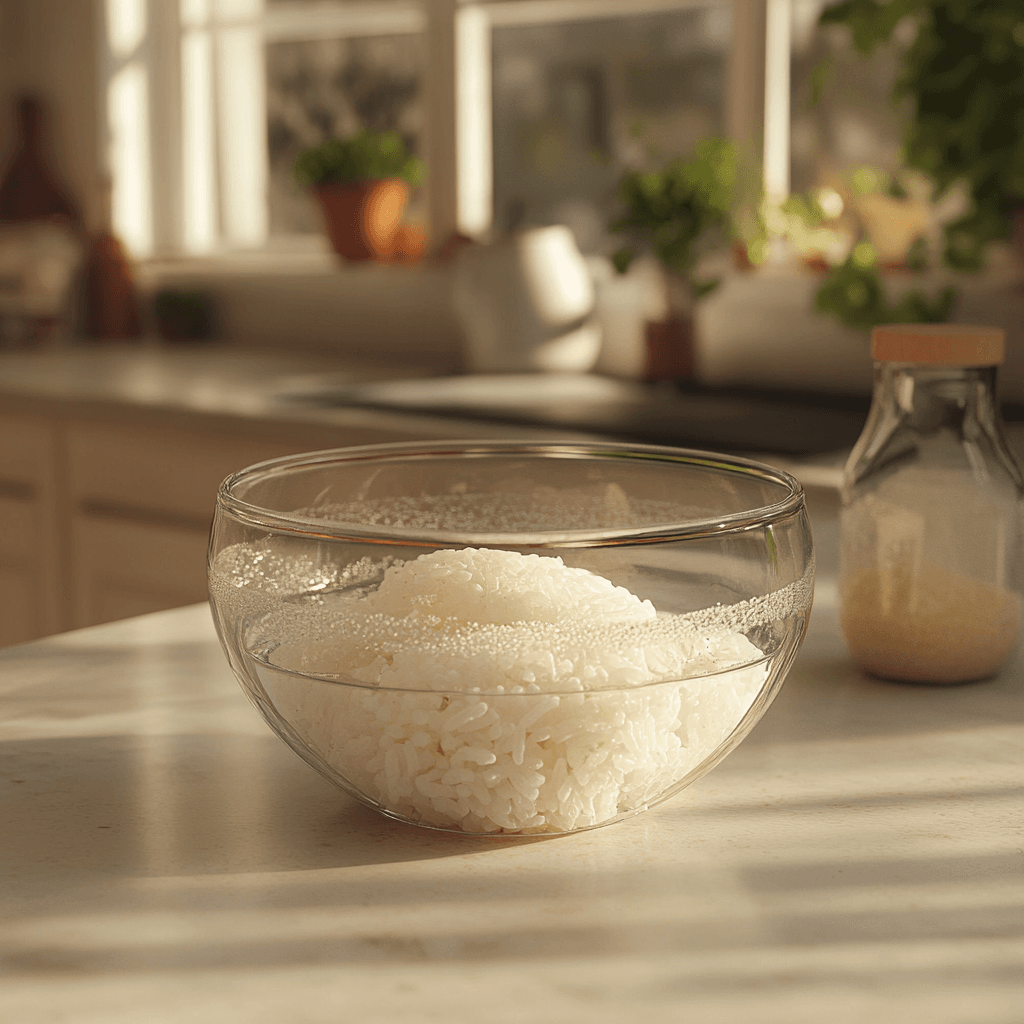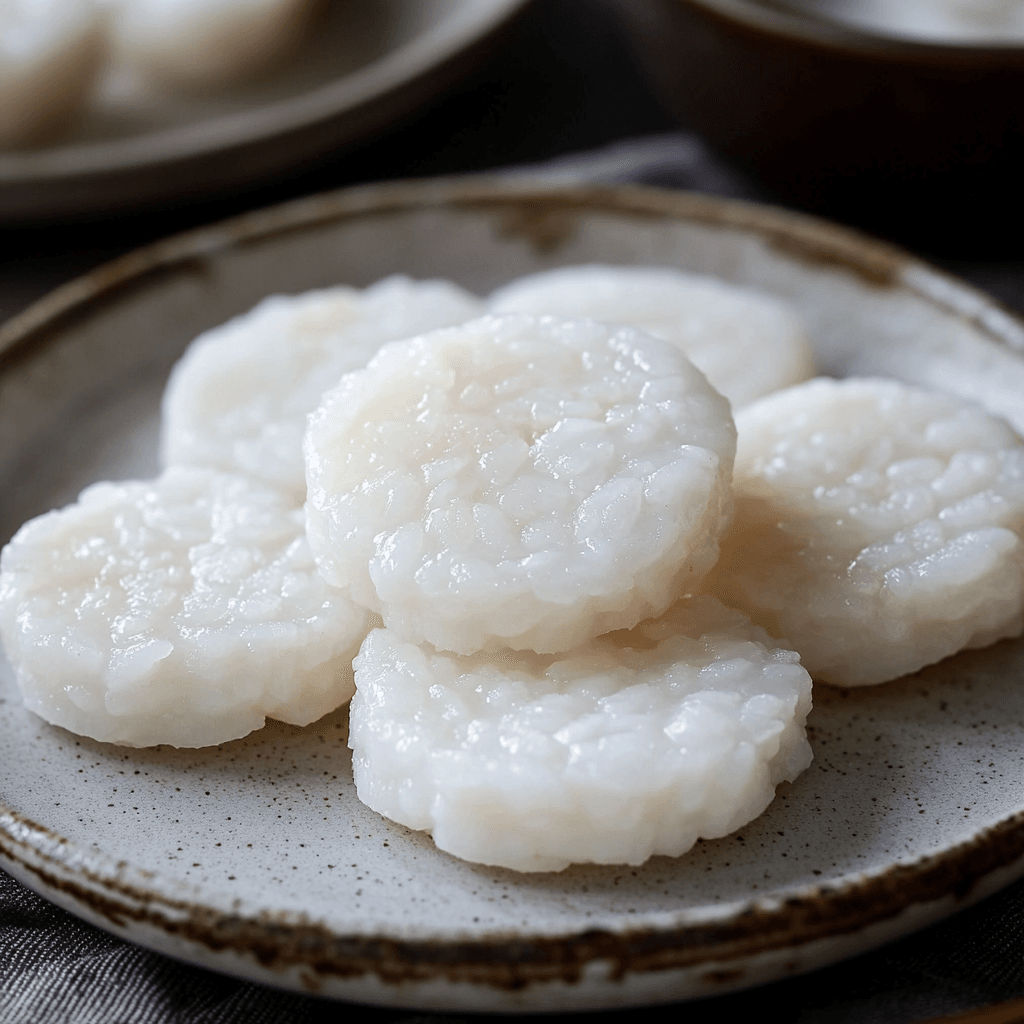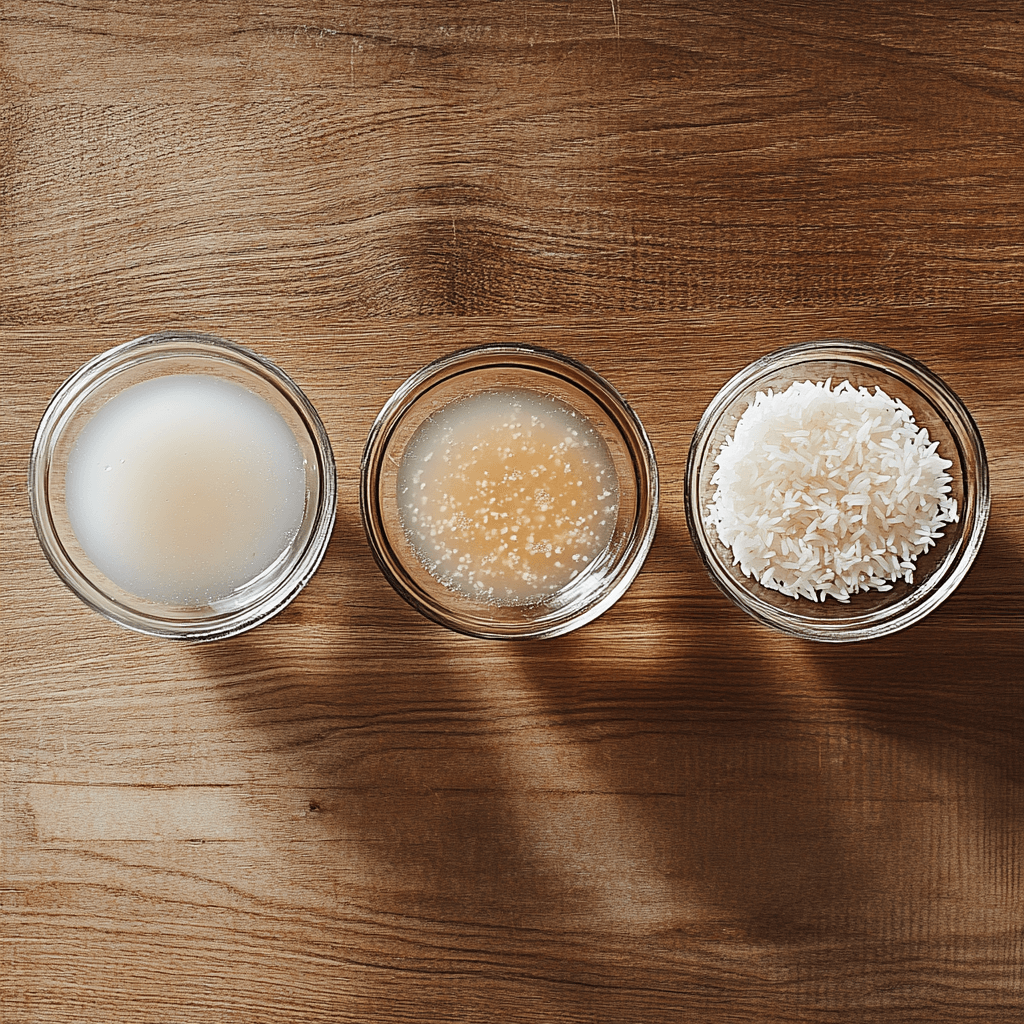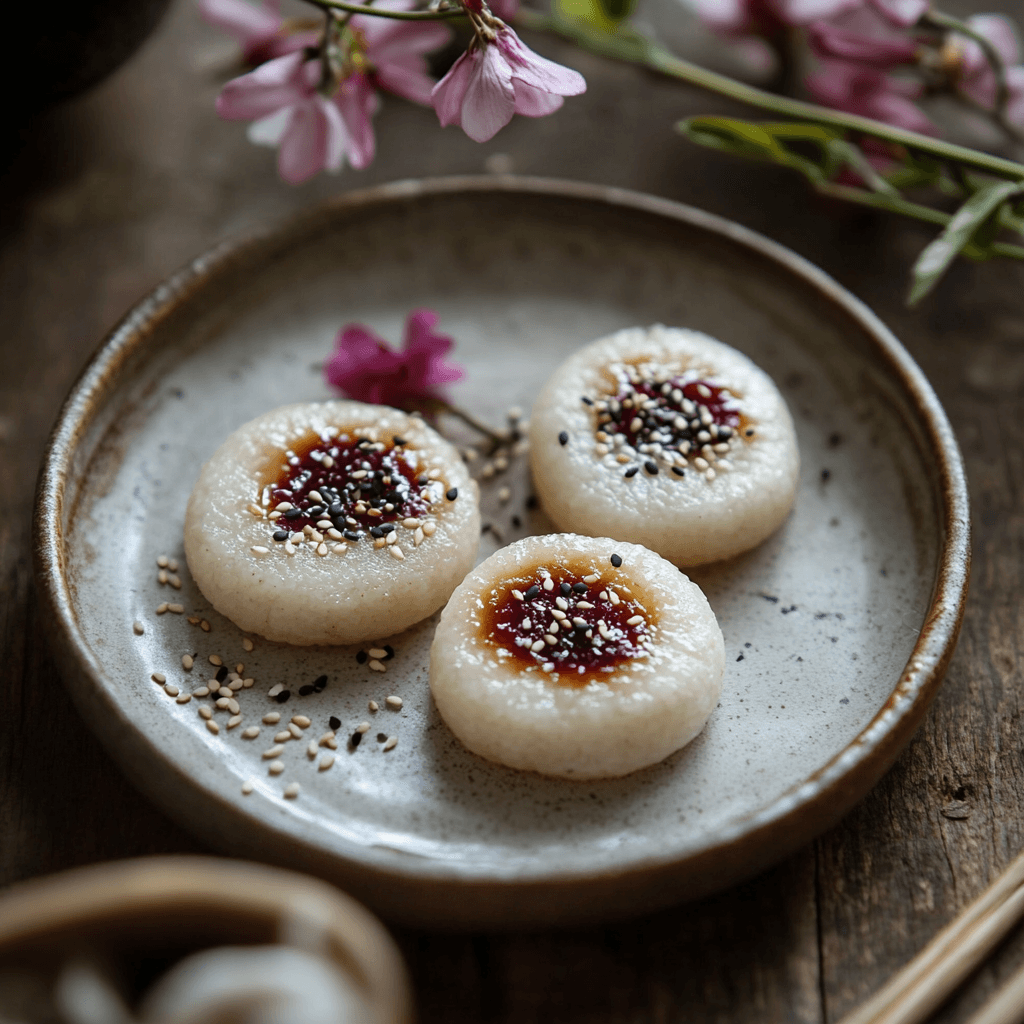
Rice cakes are a beloved staple in many Asian cuisines, recognized for their chewy texture and versatility in both savory and sweet dishes. However, if you’ve ever handled rice cakes, you may have noticed that they’re often firm and dry, especially when purchased pre-packaged. This leads many to wonder: why do people soaking rice cakes?
The practice of soaking rice cakes is both a culinary tradition and a practical necessity. By soaking, these dense, starch-rich cakes become softer, more pliable, and better suited for various recipes. Soaking isn’t just about texture—it enhances flavor, improves digestibility, and ensures even cooking. In this article, we’ll explore the reasons behind this common practice, delve into the science, and provide tips to get the best results when preparing rice cakes.
Table of Contents
Benefits of Soaking Rice Cakes
One major reason why people soaking rice cakes is to improve their texture. Soaked rice cakes become soft and chewy, a desirable quality in both stir-fries and soups.
Another benefit of soaking rice cakes is their ability to absorb flavors more effectively. This is a key reason why people soaking rice cakes before cooking.
Enhanced Texture and Consistency

Rice cakes are typically dense and hard, especially when stored for long periods. Soaking softens their texture by allowing water to penetrate their surface, making them chewy and elastic. This transformation is critical for achieving the signature texture that complements dishes like stir-fried rice cakes or hearty stews.
Without soaking, rice cakes may remain too tough or unevenly cooked, detracting from the overall dish. The process ensures a smooth and consistent texture that absorbs flavors better during cooking.
Faster Cooking Time
Dry rice cakes take significantly longer to cook and may require excessive boiling or simmering to become tender. Soaking cuts down cooking time by pre-hydrating the rice cakes, allowing them to cook more evenly and quickly. This time-saving benefit is especially useful when preparing complex recipes with multiple ingredients.
For instance, when making a quick stir-fry or soup, soaked rice cakes integrate seamlessly without requiring extended simmering, streamlining the cooking process.
Flavor Absorption
One of the most notable benefits of soaking rice cakes is their improved ability to absorb flavors. When soaked, the softened cakes act like sponges, readily soaking up marinades, broths, or seasonings during cooking. This is particularly important for dishes like tteokbokki, a Korean spicy rice cake dish, where the cakes need to be infused with the bold, spicy-sweet sauce.
Even plain water soaking preps rice cakes to take on flavors better during cooking, ensuring they are flavorful and not bland.
Improved Digestibility
Soaking rice cakes also aids in making them easier to digest. The process breaks down some of the complex starches present in the rice cakes, reducing the strain on the digestive system. For individuals with sensitive stomachs, soaked rice cakes are less likely to cause bloating or discomfort compared to their dry counterparts.
Additionally, soaking can help eliminate excess preservatives or other additives commonly found in packaged rice cakes, further improving their digestibility and nutritional quality.
These benefits highlight why soaking rice cakes is a standard practice in many kitchens worldwide. The process ensures better texture, quicker cooking, deeper flavor infusion, and improved digestibility, making it an essential step for preparing this beloved ingredient.
The Science Behind People Soaking Rice Cakes
Soaking rice cakes might seem like a simple step, but there’s a fascinating science behind why it works. From hydrating starches to removing unwanted residues, soaking transforms rice cakes into the perfect culinary ingredient. Let’s dive deeper into the mechanisms at play.
How Soaking Rice Cakes Hydrates Starches
Rice cakes are made primarily from rice flour, a starch-rich ingredient. In their dry or hardened form, the starch granules are tightly packed and resistant to water absorption. When soaked, water penetrates the surface and gradually fills the spaces between the starch granules, rehydrating the rice cake.
This hydration process is essential for restoring the soft, chewy texture that rice cakes are known for. Proper soaking also prevents the rice cakes from cracking or falling apart during cooking, ensuring they remain intact while still tender.
Key Scientific Insight: The gelatinization of starch occurs when soaked rice cakes are heated during cooking, giving them their characteristic elasticity and chewiness.
Why Removing Preservatives From Rice Cakes Matters
Store-bought rice cakes often contain preservatives, such as citric acid or sodium-based additives, to extend their shelf life. These chemicals can leave an unpleasant aftertaste or alter the natural flavor of the rice cakes. Soaking acts as a gentle cleaning process, washing away these unwanted elements.
For optimal results, it’s recommended to rinse the rice cakes under cold water before soaking. This step removes surface residues and ensures the rice cakes are ready for flavor absorption.
Softening the Structure
When rice cakes are dried or vacuum-sealed for storage, their structure becomes rigid. Soaking reactivates the moisture within the cakes, loosening the tightly bound starch molecules. This process not only softens the rice cakes but also ensures that they heat evenly during cooking.
For example, without soaking, the exterior of a rice cake might overcook while the interior remains underdone. Pre-soaking balances this disparity, resulting in a uniform texture throughout.
Impact on Cooking and Flavor Infusion
The science of soaking doesn’t stop at texture—it plays a critical role in flavor absorption. When soaked, rice cakes develop small, water-filled channels that act as pathways for seasonings and marinades to penetrate deeply. This is why soaking rice cakes often taste richer and more flavorful than their unsoaked counterparts.
Preventing Common Issues
Soaking rice cakes also helps to address common cooking challenges:
- Preventing sticking: Dry rice cakes tend to clump together when cooked. Soaking separates them, ensuring they cook evenly without sticking.
- Avoiding cracking: Soaked rice cakes are more pliable, reducing the risk of breaking or crumbling during cooking.
Understanding the science behind soaking rice cakes sheds light on why this step is so crucial. It’s not just a culinary tradition—it’s a scientifically grounded practice that improves every aspect of preparing rice cakes, from texture and cooking to flavor and digestibility.
Methods of Soaking Rice Cakes

Soaking rice cakes might seem straightforward, but the method you choose can greatly impact the outcome, depending on the recipe or the desired texture. Whether you’re preparing a quick snack or a complex dish, understanding the different soaking techniques is essential. Below, we’ll explore several effective methods to soak rice cakes and their unique advantages.
Cold Water Soak
The cold water soak is the most common and straightforward method. It’s ideal for preserving the integrity of the rice cakes, especially when they’re intended for stir-fried or soup-based dishes. This method works well for store-bought rice cakes, which are often vacuum-sealed and firm.
Steps:
- Place the rice cakes in a large bowl.
- Cover them with enough cold water to fully submerge them.
- Let them soak for 1 to 2 hours, depending on their size and hardness.
Why It Works: Cold water rehydrates the rice cakes slowly, ensuring they soften without becoming mushy. This method is particularly useful for maintaining the chewiness required in dishes like tteokbokki or stir-fries.
Warm Water Soak
For those short on time, a warm water soak is a quicker alternative. This method uses slightly heated water to expedite the softening process, making it ideal for last-minute cooking.
Steps:
- Heat water until it’s warm to the touch (not boiling).
- Submerge the rice cakes in the warm water.
- Allow them to soak for 20 to 30 minutes, checking their texture periodically.
Why It Works: The warmth speeds up water absorption, softening the rice cakes more quickly. However, care must be taken to avoid using water that’s too hot, as it can cause the rice cakes to over-soften or lose their shape.
Milk or Broth Soak
For a unique twist, some chefs soak rice cakes in milk or broth to infuse them with flavor before cooking. This technique is especially popular in fusion dishes or when rice cakes are used in creamy or flavorful stews.
Steps:
- Choose a liquid that complements your recipe (e.g., chicken broth for savory dishes or milk for creamy sauces).
- Submerge the rice cakes fully in the chosen liquid.
- Let them soak for 30 minutes to 1 hour, depending on the desired level of flavor infusion.
Why It Works: Unlike water, milk or broth introduces additional flavors, enhancing the overall taste of the final dish. This method works exceptionally well for recipes that feature rich, creamy, or umami-forward profiles.
Rinsing and Quick Soak
For rice cakes that don’t require extensive softening—such as fresh or slightly dried varieties—a rinse and quick soak may suffice.
Steps:
- Rinse the rice cakes thoroughly under cold running water to remove surface residue.
- Place them in a bowl and cover them with warm water.
- Let them soak for 10 to 15 minutes, just enough to soften the outer layer.
Why It Works: This method is best for fresh rice cakes or those already partially hydrated. It ensures the rice cakes are clean and ready for cooking without over-soaking.
Soaking Tips for Optimal Results
- Check regularly: Over-soaking can make rice cakes overly soft and prone to breaking during cooking.
- Adjust soaking time based on dish: For stir-fries, aim for firmer rice cakes, while soups and stews benefit from softer ones.
- Rinse before soaking: Especially for store-bought rice cakes, rinsing removes excess starch and preservatives, ensuring a clean flavor.
Each soaking method has its own unique benefits, catering to different recipes and cooking styles. By choosing the right approach, you can ensure your rice cakes are perfectly prepped for any dish.
Culinary Applications for Soaked Rice Cakes
Once rice cakes are soaked, their versatility shines across a range of culinary traditions and dishes. Their soft, chewy texture can complement both savory and sweet recipes, making them a favorite ingredient in various cuisines. Let’s explore some popular culinary applications for soaked rice cakes.
Stir-Fried Rice Cakes
One of the most beloved ways to enjoy rice cakes is in stir-fried dishes. These recipes often feature vibrant vegetables, savory sauces, and protein-rich ingredients, all enhanced by the chewy texture of the rice cakes.
Popular Dishes:
- Korean Tteokbokki: A spicy and sweet stir-fried rice cake dish made with gochujang (red chili paste), fish cakes, and scallions.
- Chinese Stir-Fried Rice Cakes: Often paired with soy sauce, bok choy, and pork or shrimp for a savory, umami-packed meal.
Cooking Tip: Pre-soaked rice cakes absorb stir-fry sauces better, ensuring each bite is flavorful and evenly coated. Cook them on medium heat to prevent sticking or over-softening.
Soups and Stews
Soaked rice cakes are a perfect addition to hearty soups and stews. Their ability to hold their shape while absorbing flavors makes them a go-to ingredient for broth-based recipes.
Popular Dishes:
- Korean Tteokguk: A traditional rice cake soup served during Korean New Year, featuring sliced rice cakes, beef broth, and garnishes like egg strips and seaweed.
- Spicy Rice Cake Stew: A variation of tteokbokki with additional broth, creating a stew-like consistency that’s both comforting and flavorful.
Cooking Tip: Add the soaked rice cakes toward the end of cooking to prevent them from becoming too mushy. This helps maintain their signature chewy texture.
Sweet Rice Cake Recipes

Rice cakes aren’t limited to savory dishes—they’re a popular base for sweet desserts in many cultures. When soaked and cooked, rice cakes take on a soft, pudding-like consistency, perfect for pairing with sweet ingredients.
Popular Dishes:
- Mochi and Sweet Tteok: These desserts often use sweetened rice cakes, paired with fillings like red bean paste, sesame, or crushed peanuts.
- Rice Cake Pudding: A fusion dessert where soaked rice cakes are simmered in coconut milk, sugar, and vanilla for a creamy treat.
Cooking Tip: For sweet recipes, consider soaking rice cakes in milk or lightly sweetened water to infuse a subtle sweetness before cooking.
Fusion Dishes
Soaked rice cakes are increasingly used in innovative, cross-cultural recipes. Their neutral flavor and unique texture make them an exciting ingredient in modern dishes.
Popular Dishes:
- Cheese Tteokbokki: A Korean-Italian fusion featuring rice cakes topped with melted mozzarella cheese.
- Rice Cake Skewers: Grilled rice cakes brushed with soy-based sauces, perfect for appetizers or snacks.
Cooking Tip: For fusion dishes, experiment with different soaking liquids like broth, tea, or even wine to add unexpected flavor profiles.
Preparation and Presentation Tips
- Cut to Size: Slice large rice cakes into smaller pieces after soaking for even cooking.
- Pair with Contrasting Textures: Combine the chewy texture of rice cakes with crispy vegetables or crunchy nuts for a dynamic dish.
- Garnish Generously: Top with fresh herbs, sesame seeds, or grated cheese to elevate presentation and taste.
Soaked rice cakes are a culinary canvas, lending themselves to countless recipes and techniques. Whether you prefer savory stir-fries, warming soups, or decadent sweets, their versatility makes them a standout ingredient in any kitchen.
Frequently Asked Questions (FAQs)
To wrap up our exploration of why people soak rice cakes, here are some frequently asked questions that address common concerns and curiosities about the process.
How long should rice cakes be soaked?
The soaking time depends on the type of rice cake and the dish being prepared.
- Store-bought rice cakes: Typically require 1-2 hours in cold water or 20-30 minutes in warm water to achieve the desired softness.
- Fresh rice cakes: Often need only a quick rinse or 10-15 minutes of soaking.
- For soup or stew recipes: Soaking for at least an hour ensures they cook evenly without absorbing too much broth during cooking.
Pro Tip: Always check the texture during soaking. They should be soft but not mushy.
Can you cook rice cakes without soaking?
Yes, but it’s not recommended. Cooking dry rice cakes directly can result in uneven texture, with the exterior becoming overcooked while the interior remains hard. Additionally, unsoaked rice cakes take longer to cook and are less likely to absorb flavors effectively.
When to Skip Soaking:
- When using fresh rice cakes straight from the market or preparing dishes that require long simmering, as they can soften during cooking.
Are there alternatives to soaking rice cakes?
If you’re short on time, there are a few alternatives to traditional soaking:
- Boiling: Cook rice cakes in boiling water for 5-7 minutes to soften them quickly, then rinse with cold water to prevent sticking.
- Steaming: Steam the rice cakes for 10-15 minutes to rehydrate them gently while preserving their shape.
Drawback: These methods may alter the texture slightly, making them softer than soaking would.
Why do some rice cakes fall apart when soaked?
This issue usually occurs with poor-quality rice cakes or if they’re soaked for too long. Over-soaking can cause the starches to break down excessively, leading to a mushy texture.
How to Prevent This:
- Use cold or lukewarm water instead of hot water for soaking.
- Monitor the soaking time carefully, especially for thin or small rice cakes.
- Choose high-quality rice cakes that are less likely to degrade when soaked.
Can soaking affect the nutritional content of rice cakes?
Soaking itself does not significantly impact the nutritional value of rice cakes. However, it can help:
- Remove excess sodium or preservatives found in store-bought rice cakes.
- Enhance digestibility by breaking down complex starches.
Pro Tip: Retain nutritional value by soaking in plain water or broth rather than heavily salted or flavored liquids, especially if you’re watching your sodium intake.
What are the best liquids to use for soaking rice cakes?
Water is the most commonly used liquid, but you can experiment with alternatives based on the recipe:
- Broth: Adds a savory depth to rice cakes before cooking.
- Milk: Infuses creaminess, ideal for sweet recipes.
- Tea or Herbal Infusions: Introduces subtle flavors for unique dishes.
Note: Avoid acidic liquids, like vinegar-based marinades, as they can break down the starch structure and make the rice cakes overly soft.
Conclusion
Soaking rice cakes is a simple yet transformative process that enhances their texture, flavor, and versatility. Whether you’re preparing a spicy stir-fry, a hearty soup, or a sweet dessert, soaking ensures your rice cakes are perfectly prepped to take center stage in your culinary creations. By understanding the science, methods, and benefits of soaking, you can elevate this humble ingredient into something truly spectacular.
By now, it should be clear why people soak rice cakes before cooking. This simple yet transformative process improves texture, enhances flavor, and ensures rice cakes are ready for any recipe. Whether you’re making stir-fries, soups, or desserts, soaking is a crucial step in preparing rice cakes.
Print
Why Do People Soak Rice Cakes?
Description
People soak rice cakes to soften them before cooking. Dried or refrigerated rice cakes can become hard and chewy, making them difficult to cook evenly. Soaking helps rehydrate them, improving their texture and allowing them to absorb sauces or broths more effectively. This step is especially common in dishes like Tteokbokki (Korean spicy rice cakes) or stir-fried rice cakes, ensuring they become tender and chewy instead of overly tough.
For fresh rice cakes, soaking is usually unnecessary, but for store-bought or frozen ones, a short soak in warm water (about 30 minutes) can make a big difference in achieving the perfect texture!
